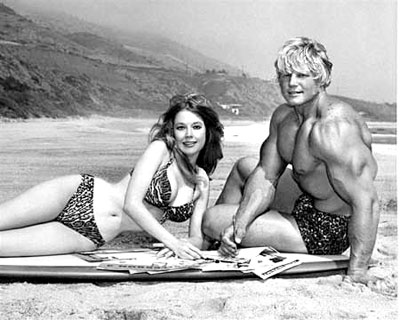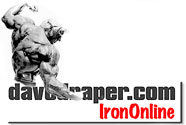Hi There. I Feel Great!

If
you'd like to download the full Draper
here newsletter in printable, live-link, pdf format,
click here.
There are those days I enter the gym looking and feeling like a life-size cardboard cutout. I have a big grin planted on my face with a little sign saying, "Hi. I feel great!" My arms and legs stick out awkwardly, immovable flaps in need of warmth and lubrication. I resemble a penguin staggering across icy tundra on a gusty day.
Warming up is imperative. Where once it took 30 seconds of snappy jumping jacks and shadowboxing, it now requires the first 10 minutes of achy slow-motion training resolve. My body’s like a worn but functional construction crane riddled with knocks and patches of rust. I crank up its engine and put it in motion. It creaks and strains as pulleys rotate and cables uncoil. The gnarled yet capable arms extend and rotate and position according to my direction from the one-man control station. Beware -- Hard Hat Area. Hands, like hooks, are lowered into place and grapple for purchase. Once they seize the intended object, a barbell or dumbbell, there is no release until the job is done. More grinding, wrenching and clumsy balance.
Set one accomplished... thud, clunk... moving right along.
Moving right along and not stopping is the trick. Body warmth achieved and gears meshing smoothly, momentum builds and the sets and reps start to flow. New dilemma: Stopping, applying the brakes, becomes the concern. I feel so good somewhere in the middle of it all, I forget I’m training, think I’m playing and trip headlong into the steel wall of overtraining. You’d think I was preparing for the 2006 Mr. O (O standing for Optical-illusion). I struggle to gain mass and density, definition and veins before the afternoon traffic builds up and I get stuck on the freeway.
When it’s time to go, I crawl down the gym’s rear stairway to the parking lot. My body follows at a safe distance. The previously prepared Bomber Blend in my gym bag will save me from extinction. I suck it down and am instantly restored... magic. I’m homeward bound.
Before we waste any more of your time with my madness, let’s unravel the last three exercises we referenced last week -- ordinary exercises transformed into elaborate movements. See how generously I include you in my bungling plans -- "we" instead of "I"?
Wide grip pulldowns --
We’re seeking the captivating taper that particularly defines a sleek, well-proportioned body: the V-shape, the hour-glass figure, wide at the shoulders -- narrow at the waist. Widegrip pulldowns performed with a few mid-set movement variations do the job totally.
Note: The only exercise that develops the latisimus dorsi better than the lat pulldown is the widegrip chin, but not everyone can perform the movement with focus, form, control and reasonably high repetitions -- 10 to 12 plus. The widegrip pulldown practiced regularly will help the avid trainee in achieving the strength and ability to perform the chin and include it in his or her exercise repertoire.
Rewards are everywhere, kids. Don’t lose your childhood curiosity.
This exercise description stuff can get boring, so I’ll get to the point. I include three specific movements within the one exercise: grasping the bar (oh, that you might have the advantage of grasping a thickbar handle) at a reasonable width -- 12 to 18 inches to left and right of shoulder width, and positioning myself with my back to the cable apparatus, I pull the bar behind my neck to the base of the skull. Be thoughtful always. Hunching the back or pitching the head forward disrupts the muscle recruitment. I seek a tight contraction throughout the upper back, across the rear delts and biceps, and effectively return the bar to its fully extended starting position. Six reps load and fatigue the back but don’t exhaust it totally.
Without pause I assume a position facing the apparatus directly under the pulley -- mid-set nimbleness -- and pull the bar straight down to the forehead. The initial tug is executed with particular attention on the lat’s uppermost insertions -- the region where the lats begin, their widest expanse. Three or four reps are enough to reach maximum burn and assure, in time, maximum width. The last three or four reps are virtual backward-leaning body thrusts to finish the deed. You hang on for dear life. At the peak of this motion, the bar reaches for the mid-pec area, as the back is arched in mighty muscle contraction. These are robust, full extension to full contraction movements that lay claim to the entire back.
Releasing the bar is a victory. You drift away as your lats pick up minor air currents; a wind can be catastrophic.
Machine dips --
Freehand dips work great if you have the faculty to do them. They, like chins, are priceless and preferred, but can be difficult to manage when introducing mid-set modifications. Considering this limitation, dips performed on a resistance-controlled machine enable the musclebuilder of every level to enjoy their benefits.
The basic up-and-down motion involves the triceps, shoulder and upper back muscles and along the pec line. Four to five sets of high reps -- 12-15 -- afford plenty of action to engage each muscle area sufficiently, and each area is accentuated by the particular groove of the exercise performed. Got that? Words are like meatballs at an Italian wedding; they’re everywhere, more than necessary, but there’s no celebration without them.
Groove one: Using a moderately wide grip -- shoulder width plus three inches on the left and right -- round your back, thus isolating the back region, and lower yourself fully; concentrate to locate and flex the targeted broad back musculature and push upward to the starting point. Repeat for six reps to maximize your upper back investment.
Groove two: Replace the rounded back with an arched posture and lean into your dipping motion as you seek to involve the pectoral area. Different muscle recruitment allows another four reps of burning action. Focus while you still can... sneak in a final smile. The pecs join the back in max-muscle saturation -- steam rises, and the triceps are beginning to sizzle.
Groove three: We’re zeroing in on the triceps, a high-tension muscle group familiar with reps. An erect upper body posture enables you to tilt backward, shifting the merciless resistance to the triceps. They’re good for three or four reps before they explode and a general mop-up is required. Windex and double-ply paper towels -- the mess is worth the pump and pain and eventual growth.
Exercises are for twits. Movements are for bombers
One-arm dumbbell row --
Whereas pulldowns and chins add width to one’s back, dumbbell rows add power and muscle thickness. I start with a reasonable weight for 10 to 12 reps and work my way up the rack to four or six reps for the final set, sometimes doubles and singles when the stars are right.
To satisfy our musclebuilding quests, where muscle fullness is a prime target, I find the moderate rep-range most effectual. Therefore, heavy weight gives way to moderate, manageable weight. Reps go where you direct them for maximum muscle effect, not anywhere any way you can.
I assume a three-point equidistant stance with the upper body leaning forward the legs and the forearm resting on a handy dumbbell rack. Most stable. I mention this cuz I’ve assumed this powerful position since training in Vic Tanny’s Gym in Jersey 45 years ago. There’s no other way, see! Kneeling on a bench for support is for boy scouts. Before affecting my various rowing motions, I secure a grip of steel. Strengthening the grip and developing the forearms should always be included among your purposes for lifting the iron and moving the steel. Using hand straps is for girl scouts... or apes setting world records.
The first action is pulling the dumbbell with vigor from a hanging position to a place high and above the deltoid. This is a sweeping motion that resembles a one-arm bentover lateral raise. Sounds ambitious, but the back and torso are engaged simultaneously, giving thrust to the dumbbell, yet always demanding muscle control. This is not an arbitrary weight toss. At the peak of the movement, contraction is directed to the upper back and rear delt region; a controlled negative adds muscle exertion to the upper back and the entire length of the lat. The fact that one side of the body at a time is being engaged allows this grand action, and exertion of force and energy. Five is the outside number of reps for this phase.
The second action is the old-fashioned lawnmower pull. However, our lawn mower is hunky and requires a full forward extension of the dumbbell and a magnificent tug, bringing the dumbbell to the vicinity of the... um... armpit. Contract big-time. Four, five or six reps will start anybody’s grass cutter. We just concentrated on the deep muscles of the back; the ones that give ridges and lumps and might to the broad sweeping expanse.
Pulling the dumbbell straight up and down with a minimum of thrust is the wisest expenditure of the remaining energy, will and consciousness. This mass-building motion exerts the upper-back muscles with no energy or force lost to defining lat length or rippley stuff. Do what you can in these culminating three or four reps. I don’t have the nerve -- the audacity -- to define rigid requirements moments before you pass out.
Now for the other side. He he he...
The variation in exercise groove expanding an exercise into a movement is a working principle I’ve developed over the years by intuition, need and desire. The internal transitions happen smoothly and by feel. They work. They are not complex intelligent designs. If intelligence were to rule weightlifting, we bombers would need to seek another diversion.
I’ve stepped into the red zone. My silent mouth has joined my busy fingers (both of them) at the keyboard and thoughts like dust now cover your screen. I’ll stop here and lash my craft to the blacktop. Strong winds are coming from the east. Good sign, wing-rats. Spring’s not that far off. Train hard. Eat right. Drink your Bomber Blend. Take your Super Spectrim. Pray for our heroes in the military. Keep smiling and no one will know what you're thinking. That's about all the advice I have for today.
Pick your personal closing:
Get Huge... The Drapes
Get Ripped... Draper
Blast it... The Bomber
Bombs Away... Your Captain
Fly High... DD
May your workouts be fun and rewarding... David Paul Draper
[Certified Personal Trainer, Author, Actor, Bomber, Bodybuilder, President and CFO -- IronOnline, CEO -- On Target Publications, World-renown Philanthropist and Benefactor, Secret Agent and Gang Leader.]
Laree here...
Long-time readers will remember a monthly book club discussion hashed out in the IronOnline group several years ago. Since then, we've moved from that email group to a board forum making the whole thing accessible to more people, but we hadn't brought back the book discussions until a couple of weeks ago when Corey Pavitt (the next Mr. Alaska) stirred up new interest.
It took about a nanosecond to choose the first book for review -- Bill Starr's The Strongest Shall Survive -- because a number of the forum members have used Bill's book for the past three decades to guide them to strength and health. And that exceptional information they've passed along to the rest of us come-latelys.
This is an especially good choice for a group like this to work through since it covers not only weight training routines and exercises, but also has an extensive nutrition section documenting the various vitamins, minerals and some of the off-the-beaten-path nutrient sources such as Brewer's yeast and lecithin.
Don't let the subtitle, Strength Training for Football, throw you off course. Following Bill's weight training suggestions will make you stronger, period. It's something we all need, and frankly, it's something many of us don't strive for, at least not past the initial -- read, easy -- strength gains that come when we begin our musclebuilding efforts.
The book discussion begins February 6, and will be monitored by Dr. Ken Leistner and Dan Martin, experts in SSSS (Starr's Strongest Shall Survive, silly!), who are sure to set us straight when we go astray. As a finale, Bill Starr joins us to answer our remaining questions in early March, after which the entire discussion will be archived for later reference.
Here's where the Bill Starr action takes place.
And if you'd like a copy to get a headstart, you can pick one up at IronMind, here.
If you want a copy, but would prefer not to order online, you can send a check or money order to the publisher, $19.95 plus $6 shipping, to Fitness Consultants and Supply, 1011 Warwick Drive, 3-C, Aberdeen, MD 21001.
I don't think you'll be sorry. There's something in this book for everyone. Even without the book, I'm certain you'll gain a truckload of knowledge by visiting the discussion forum in February. In fact, you may end up learning how heavy lifts work: They really, really work. Beauty!
Laree
The DVD includes a one-hour-and-fifteen-minute tape of the July seminar, two muscular slide shows, plus a 32-page booklet outlining the subsequent interview between the mighty one, Bill Pearl, and me in which we discuss some favorite subjects untouched by the seminar.
To order your copy of the Bash 05 Seminar dvd with Dave and Bill Pearl click here.
Did
you sign up for Dave's expanded
email yet?
It's
free, motivating and priceless!
We'll also send you a link to Dave's free Body Revival
Tips and Hints booklet with your confirmation notice.
May we answer any bodybuilding questions for you in our forum?
If you haven't yet read Dave's bodybuilding book, Brother Iron, Sister Steel, here's more information.
You may also enjoy our ongoing weight training and fitness article blog, which we update with new material several times each week.
Are you in the mood for reading an weight training book excerpt?
Can I tell you about whey protein powders?
Could you use a new 8-week workout routine or a bodypart workout program? Need to learn how to squat or how to deadlift?
Or select a link to the left to discover our most popular pages that are sure to answer all your training questions..


